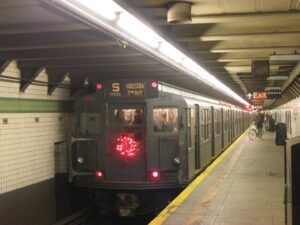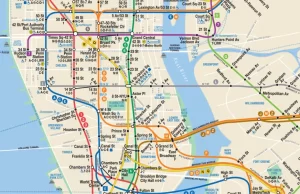 In areas of the country that are more rural, most everyone has their own car, and while we have bus systems, the majority of people drive themselves to do their errands and such. In large metropolis places, like New York City, however, where parking is hard to find, and costs a fortune, many people choose not to own a vehicle. That said, getting around there is not as easy as it is for those of us who simply go out and get in our car, and drive away. For New York City the best solution was to build a subway. As most people know, a subway is a rapid transit system. The one in New York City serves four of the five boroughs of New York City, including the Bronx, Brooklyn, Manhattan, and Queens. The subway is operated by is the New York City Transit Authority (NYCTA), which is controlled by the Metropolitan Transportation Authority (MTA) of New York. In 2016 alone, an average of 5.66 million passengers used the system every day, making it the busiest rapid transit system in the United States and the seventh busiest in the world.
In areas of the country that are more rural, most everyone has their own car, and while we have bus systems, the majority of people drive themselves to do their errands and such. In large metropolis places, like New York City, however, where parking is hard to find, and costs a fortune, many people choose not to own a vehicle. That said, getting around there is not as easy as it is for those of us who simply go out and get in our car, and drive away. For New York City the best solution was to build a subway. As most people know, a subway is a rapid transit system. The one in New York City serves four of the five boroughs of New York City, including the Bronx, Brooklyn, Manhattan, and Queens. The subway is operated by is the New York City Transit Authority (NYCTA), which is controlled by the Metropolitan Transportation Authority (MTA) of New York. In 2016 alone, an average of 5.66 million passengers used the system every day, making it the busiest rapid transit system in the United States and the seventh busiest in the world.
As New York City grew (it currently has 10 times the amount of people as Wyoming – the smallest state by population), it became obvious that there was going to have to be a public transport system. Work began on  the New York Subway on March 24, 1900, and the first underground line opened on October 27, 1904. The opening of the subway was almost 35 years after the opening of the first elevated line in New York City, which became the IRT Ninth Avenue Line. By the time the first subway opened, the two elevated lines had been consolidated into two privately owned systems, the Brooklyn Rapid Transit Company (BRT, later Brooklyn–Manhattan Transit Corporation, BMT) and the Interborough Rapid Transit Company (IRT). All lines built for the IRT and most lines for the BRT were built by the city and leased to the companies after 1913. When the first line of the city-owned and operated Independent Subway System (IND) opened in 1932, it was intended to compete with the private systems and replace some of the elevated railways. The problem was that it was required to be run “at cost,” By necessity, the fares were up to double the five-cent fare, that was popular at the time…thereby, completely defeating the intended purpose.
the New York Subway on March 24, 1900, and the first underground line opened on October 27, 1904. The opening of the subway was almost 35 years after the opening of the first elevated line in New York City, which became the IRT Ninth Avenue Line. By the time the first subway opened, the two elevated lines had been consolidated into two privately owned systems, the Brooklyn Rapid Transit Company (BRT, later Brooklyn–Manhattan Transit Corporation, BMT) and the Interborough Rapid Transit Company (IRT). All lines built for the IRT and most lines for the BRT were built by the city and leased to the companies after 1913. When the first line of the city-owned and operated Independent Subway System (IND) opened in 1932, it was intended to compete with the private systems and replace some of the elevated railways. The problem was that it was required to be run “at cost,” By necessity, the fares were up to double the five-cent fare, that was popular at the time…thereby, completely defeating the intended purpose.
While the city tried to keep the elevated system running too, and succeeded to a degree, many were had to be closed, because it became too expensive to maintain them. Graffiti, crime, and dilapidation became common. The New York City Subway had to make many service cutbacks and defer necessary maintenance projects just to stay solvent. In the 1980s an $18 billion financing program for the rehabilitation of the subway began. Today, the subway systems remain an important part of the transport system, in New York City. They are also vulnerable to attack, as well as simple maintenance problems. The September 11 attacks prove this without question. The attacks resulted in service disruptions, particularly on the IRT Broadway–Seventh Avenue Line, which ran directly underneath the World Trade Center. Several sections were crushed, requiring suspension of  service on that line south of Chambers Street. Work began immediately to repair the damage, and by March 2002, seven of the closed stations had been rebuilt and reopened. All but one of them. Then, on September 15, 2002, that one also reopened with full service along the line. Since the 2000s, expansions include the 7 Subway Extension that opened in September 2015, and the Second Avenue Subway, the first phase of which opened on January 1, 2017. However, at the same time, under-investment in the subway system led to a transit crisis that peaked in 2017. Subways will most likely always be an important part of transportation, especially in big cities. Nevertheless, it will also always have its vulnerabilities.
service on that line south of Chambers Street. Work began immediately to repair the damage, and by March 2002, seven of the closed stations had been rebuilt and reopened. All but one of them. Then, on September 15, 2002, that one also reopened with full service along the line. Since the 2000s, expansions include the 7 Subway Extension that opened in September 2015, and the Second Avenue Subway, the first phase of which opened on January 1, 2017. However, at the same time, under-investment in the subway system led to a transit crisis that peaked in 2017. Subways will most likely always be an important part of transportation, especially in big cities. Nevertheless, it will also always have its vulnerabilities.


Leave a Reply